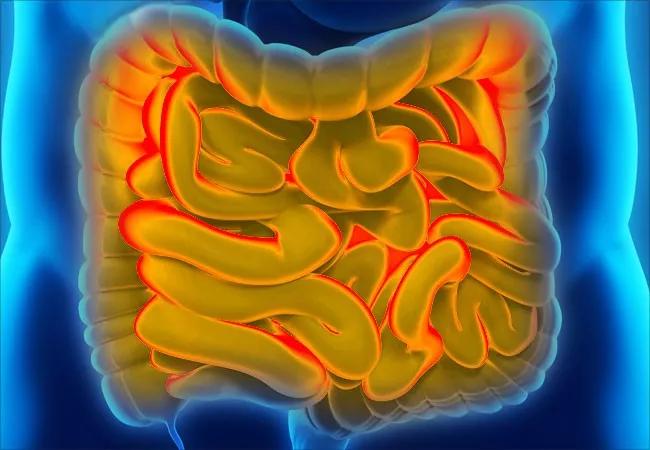Cleveland Clinic conducts comprehensive review of IBD's widespread effects

Inflammatory bowel disease (IBD) is unique among gastrointestinal diseases in its effects on nearly every major organ system.
Cleveland Clinic is a non-profit academic medical center. Advertising on our site helps support our mission. We do not endorse non-Cleveland Clinic products or services. Policy
Extra-intestinal manifestations (EIMs) are common in IBD, occurring in 31% of Crohn’s disease (CD) patients and 43% of ulcerative colitis (UC) patients. They are more prevalent in women (50%) than men (34%). In IBD patients with EIMs, approximately 63% exhibit one and 27% two; having one EIM increases susceptibility to additional EIMs.
“EIMs cause many symptoms that can be debilitating. Patients often tell me that the extra-intestinal manifestation is worse than their inflammatory bowel disease,” says Miguel Regueiro, MD, Chair of Cleveland Clinic’s Department of Gastroenterology, Hepatology and Nutrition and Vice Chair of the Digestive Disease & Surgery Institute.
Dr. Regueiro’s main clinical and research interest is IBD. He and his gastroenterology colleague, Ari Garber, MD, recently conducted a comprehensive review of IBD EIMs, including recommendations for management and treatment of these complex conditions.
IBD results from a combination of genetic predisposition, dysregulation of innate and adaptive immune response, and environmental exposure, including changes in the gut microbiome. Inflammation begins in the gastrointestinal tract. The dysregulated immune system also attacks various other parts of the body.
Genetic antecedents may predispose some patients with IBD to develop EIMs. In families with IBD, parent-child and sibling EIM concordance is approximately 70% and 84%, respectively.
Primary EIMs are associated with disease activity, with some exceptions. EIMs that follow the disease course respond to treatment of the underlying IBD, while those with an independent course require a separate treatment regimen.
Secondary manifestations, such as osteoporosis and venous thromboembolism, are a consequence of the inflammatory disease process or medical or surgical treatment and require additional treatment.
Musculoskeletal
Musculoskeletal manifestations are the most common class of EIM, occurring in 30% of IBD patients. The most common is peripheral arthritis: Pauciarticular (Type 1) mainly affects the knee and large joints; polyarticular (Type 2) affects small joints. Type 1 is often self-limited and mirrors IBD activity, while Type 2 has more persistent symptoms and has an independent course.
Ankylosing spondylitis (AS), a type of axial spondyloarthritis, presents as inflammatory low back pain with imaging evidence of sacroiliitis. Affecting approximately 4% of IBD patients, AS follows an independent disease course and is difficult to treat.
Orocutaneous
Common but under-recognized, orocutaneous EIMs include a heterogeneous group of conditions. The most common is erythema nodosum, which occurs in approximately 3-6% of IBD patients, predominantly female, and parallels gastrointestinal activity. It usually manifests as raised, erythematous and immobile nonulcerated painful lesions 1-5 cm in diameter, located on extensor pretibial skin.
The second most common dermatologic EIM, affecting approximately 2% of IBD patients, is pyoderma gangrenosum — an ulcerative or pustular skin lesion with an erythematous or violaceous undermined border, ranging in size from 2 to 20 cm and mainly occurring on the extensor surfaces of the legs. It follows an independent disease course and is difficult to treat.
Opthalmologic
Also common but under-recognized are ophthalmologic EIMs, which affect as much as 5% of patients. They include ocular manifestations (episcleritis, the most common, and scleritis, both of which follow the disease course); and intraocular uveitis, which follows a separate disease course.
Hepatobiliary
Primary sclerosing cholangitis (PSC) is the most common EIM associated with IBD. It is characterized by stricturing of both intrahepatic and extrahepatic large bile ducts. Approximately 70% of patients with PSC will develop IBD, mostly men (66%). Currently, there are no effective treatments and PSC patients go on to develop cirrhosis and require a liver transplant.
Pulmonary and renal
EIMs have been reported in all areas of the pulmonary tree and often mirror intestinal inflammatory activity. Renal insufficiency related to IBD can be hard to distinguish, but case reports have identified associations between IBD and glomerulopathies, secondary amyloidosis and tuberulointerstitial nephritis.
Biologic therapies have proved effective in treating IBD and EIMs. They include:
Infliximab (Remicade) — treats CD and UC and all EIMs except primary sclerosing cholangitis.
Adalimumab (Humira) — treats CD, UC and most EIMs (similar to Remicade).
Vedolizumab (Entyvio) — treats gut inflammation in both Crohn’s and UC.
Ustekimumab (Stelara) — treats CD (not yet approved for UC) and can treat psoriasis and arthritis.
Tofacitib (Xeljanz) — treats UC and can treat arthritis.
“These therapies allow patients who are quite debilitated to get back to a normal life,” says Dr. Regueiro.
At Cleveland Clinic, IBD care is multidisciplinary. A team of specialists focuses holistically on the patient, addressing diet and stress as well as the illness.
As research on IBD and EIMs progresses, “we’re going to learn more about the cause of IBD and what treatments work for EIMs,” Dr. Regueiro says. “Overall, I’m optimistic about the future for IBD patients.”

Insights on guiding treatment decisions

Strong patient communication can help clinicians choose the best treatment option

Brief pearls for diagnosis and management of ascites and relevant conditions associated with decompensated cirrhosis

Hard-to-treat GI disorders benefit from multidisciplinary approach

How an IBD specialist pharmacist enhances patient care

Rate is lower with tunneled intravenous catheters

Cleveland Clinic’s ACO takes a team of teams approach

A multispecialty team was essential for this challenging case